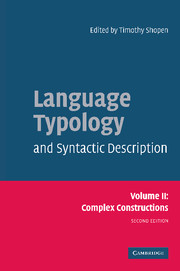Book contents
- Frontmatter
- Contents
- List of figures
- List of tables
- List of contributors
- Acknowledgements
- List of abbreviations and symbols
- 1 Coordination
- 2 Complementation
- 3 Noun phrase structure
- 4 Relative clauses
- 5 Adverbial clauses
- 6 Discourse structure
- 7 Sentences as combinations of clauses
- Bibliography
- Language index
- Subject index
3 - Noun phrase structure
Published online by Cambridge University Press: 26 December 2009
- Frontmatter
- Contents
- List of figures
- List of tables
- List of contributors
- Acknowledgements
- List of abbreviations and symbols
- 1 Coordination
- 2 Complementation
- 3 Noun phrase structure
- 4 Relative clauses
- 5 Adverbial clauses
- 6 Discourse structure
- 7 Sentences as combinations of clauses
- Bibliography
- Language index
- Subject index
Summary
Introduction
In discussing the structure of noun phrases cross-linguistically, I will assume a rather rough characterization of noun phrases, as syntactic constituents which serve as arguments of verbs. There are a variety of ways in which this is inadequate as a precise definition and there are a number of legitimate questions about exactly what ought to be considered a noun phrase, but these issues are somewhat marginal to the primary purpose of this chapter, which is to discuss some of the ways in which noun phrases differ across languages in a way that will be helpful to someone describing noun phrases in a particular language.
It is convenient for the purposes of discussion to distinguish three sorts of noun phrases: (i) simple noun phrases, which contain only pronouns or nouns plus simple modifiers like articles, adjectives, demonstratives, or numerals; (ii) complex noun phrases, which contain more complex sorts of modifiers, like genitive or possessive modifiers and relative clauses; and (iii) various sorts of noun phrases which lack a head noun. These three types are discussed in sections 1, 2, and 3 respectively.
Simple noun phrases
The most common noun phrases in many languages contain a single word which is either a noun or a pronoun. In most if not all languages, pronouns generally occur alone in noun phrases without modifiers. Constructions in which pronouns occur with modifiers, as in we linguists or something inexpensive in English, are often possible but infrequently used.
- Type
- Chapter
- Information
- Language Typology and Syntactic Description , pp. 151 - 205Publisher: Cambridge University PressPrint publication year: 2007
- 55
- Cited by

